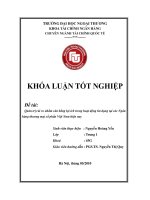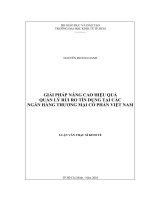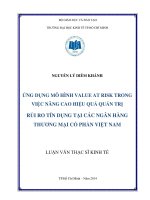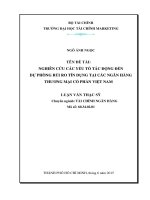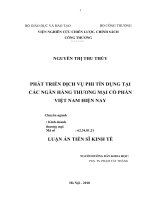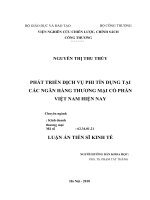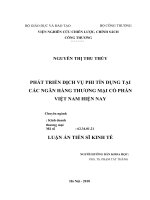Nâng cao chất lượng tín dụng tại các ngân hàng thương mại cổ phần việt nam (tt)
Bạn đang xem bản rút gọn của tài liệu. Xem và tải ngay bản đầy đủ của tài liệu tại đây (171.93 KB, 29 trang )
MINISTRY OF GOVERNMENT AND TRAINING
MINISTRY OF
FINANCE
ACADEMY OF FINANCE
DUONG THI HOAN
SUMMARY OF DOCTORAL THESIS
IMPROVING CREDIT QUALITY AT VIETNAMESE JOINT
STOCK COMMERCIAL BANKS
Major: Finance - Banking
Code:
9.34.02.01
Doctoral advisors: 1. Assoc.Prof.Dr. HA MINH SON
2. Dr. NGUYEN HO PHI HA
HA NOI – 2020
The thesis was completed at: Academy of Finance
Doctoral advisors: 1. Assoc.Prof.Dr. HA MINH SON
2. Dr. NGUYEN HO PHI HA
Panel member 1: ………………………………………………………
………………………………………………………..
Panel member 2: ………………………………………………………
………………………………………………………..
Panel member 3: ………………………………………………………
………………………………………………………..
The thesis shall be defended before Academy Doctoral Advisory Committee,
convening at Academy of Finance at …..
Find more about the thesis at:
- National Library of Vietnam
- Academy of Finance Library
2
INTRODUCTION
1. Rationale of the thesis
As a special type of for-profit organizations, commercial banks are regarded as the most
important financial intermediaries of any financial market. Among the various functions of
commercial banks, lending ranks among the most fundamental and essential business
activities. Along with the growing trend for integration of the global economy and the
development of the country, people's living standards have been considerably improved,
which mirror the increase in spending capacity and consumption demand. Responding to this
higher demand by consumer, businesses have increased their production level which in turn
accelerates the demand for credit services. Effective credit management and credit quality
control are fundamental to meeting the customers' loan demands, boosting revenue while
limiting the risks at the minimum level.
Although credit activities generate an important stream of revenue for banks, they are
inherently associated with a high level of risks. Therefore it is imperative that bank pay
adequate attention to credit quality management issues including credit safety, loan
effectiveness and sustainable development of the bank. The role of credit quality in the
growth of banks cannot be overstated. Higher credit quality means lower risk exposure in
banking activities and a higher level of competitiveness for the commercial bank in the
financial market. Therefore, a study in finding measures to improve credit quality in the
context of international economic integration and the technology revolution 4.0 has profound
implications for joint stock commercial banks.
These considerations have prompted the PhD student to choose the topic: "Improving
the credit quality at Vietnamese joint stock commercial banks" for her doctoral thesis.
2. Overview of researcj on credit quality management
There has been an extensive body of research on the issue of credit quality management
by scholars, economists and policymakers in Vietnam and abroad with regards to a number of
theoretical and practical issues. An overview of those studies is presented in the following
section.
3
2.1 Domestic research works on credit quality management
The authors Nguyen Van Tien (2015), Nguyen Dang Don (2010), Nguyen Minh Kieu
(2012) provided an assessment of credit quality in commercial banks and credit quality
analysis criteria, including qualitative and qualitative indicators. Among these indicators, the
set of qualitative indicators reflects customers’ performance and the bank's credit
management activities. The set of quantitative criteria includes indicators such as: overdue
debts, bad debts, profitability from credit activities, capital efficiency, provision and credit
risk limitations, risk diversification, setting capital adequacy ratio.
The studies by authors Tran Van Du (2010), Nguyen Thi Thu Dong (2012), Ha Thi Mai
Anh (2015), Nguyen Van Tuan (2015), etc. established a set of criteria to evaluate credit
quality in commercial banks for the new era of global integration, including quantitative
indicators showing the financial capacity of commercial banks; their credit safety levels as
well as qualitative indicators which reflect their credit management capacity, customer
satisfaction level with the banks’ financial services. At the same time, the studies also
pinpoints the factors affecting credit quality such as credit policy; screening process and
regulations; organizational issues; human resource quality, governance capacity; technology;
Credit information; Internal inspection and control; capital mobilization, etc.
Other authors including Nguyen Thi Nhu Thuy (2015), Nguyen Van Thanh (2015),
Nguyen Duc Tu (2012), Le Thi Huyen Dieu (2007), etc., focus on the issue of credit quality
as part of the overall strategies for managing credit risk, bad debt, lending efficiency,
improvement of business operations, etc.
In addition, a number of relevant conferences such as National Science Conference
(2017) on "Application of Basel 2 in risk management of Vietnamese commercial banks:
opportunities, challenges and implementation roadmap" at National Economy University.
The results of the studies presented at the conference showed that: the majority of banks have
established Basel 2 Project Management Committees; the overall capital adequacy ratio of
the banking system was higher than 10% (exceeding the required level of 9% but still falling
short of other countries in the region); commercial banks have made strides in further
improving the risk management system despite the fact that bad debts remain an imminent
threat to the stability of the banking system. Furthermore, there exist considerable
4
discrepancies in accounting principles and information disclosure requirement between
Vietnam and the international standard. Notable challenges in the implementation of Basel 2
standard identified in the studies include: human resources, equity capital growth,
establishment of database systems and implementation costs in applying Basel 2 standard at
commercial banks.
2.2 Foreign research works on credit quality management
- A. Burak Guner (2007) studied the relationship between lending opportunities and
credit quality, credit portfolio analysis. The author pointed out that the more diversified a
bank’s credit portfolio is, the higher the level of risk diversification can be achieved, leading
to improved credit quality. The author also stated that the rigor of credit standards is
dependent upon the external factors including potential borrowers. The study was conducted
with regards to general credit standards of banks in western countries
- In Faiçal Belaid ‘s 2014 study on credit quality, the author focuses on researching the
impact of the internal factors of Tunisian banks such as: management capacity, cost
effectiveness, the size of equity capital, credit growth and profitability on credit quality. The
independent variables are the GDP growth rate and the characteristics of corporate customers
which affect the quality of credit activities. The author conducted a study on 9000 businesses
that were customers of the 10 largest banks in Tunisian - Switzerland from 2001 to 2011. The
research results showed that banks which had ineffective cost structure, low equity capital,
and large discrepancy in service delivery also experienced low credit quality. GPD growth
and customer characteristics are important when assessing banks’ credit quality.
- Laivi Laidroo, Kadri Mannasoo (2017) studied credit commitments that affect credit
quality. The authors focused on analyzing the risks arising from credit growth and offbalance sheet credit commitments with the potential to grow excessively. Credit quality was
investigated both in a macro and micro context, through a survey of 28 European countries in
the 2004-2014 period and a survey of 478 European banks in the 2004-2013 period. The
dynamic panel data estimation results confirm that an increase in the ratio of credit
commitments to total assets is a warning indicator of growth in the ratio of non-performing
loans and loan loss reserves. Simultaneous equation estimation illustrates the adverse effect
of credit commitments on credit quality stems from the credit boom scenario. The economic
5
impact of credit commitments to credit quality is significant compared to that of traditional
credit quality indicators (real GDP growth and real growth in loans).
2.3 Gap in previous studies
Through a broad overview of previous studies, the PhD student found that there exist
several gap in the body of research related to improving credit quality in commercial banks:
Regarding theoretical research:
Studies on improving credit quality based on theoretical frameworks have not been
systematic and reflected a current picture of credit quality situations at commercial banks in
the modern era, especially during the period the State Bank of Vietnam is implementing the
roadmap for meeting Basel 2 Accord.
Regarding empirical research
Firstly, previous studies on credit quality within commercial banks mainly involve the
following issues: credit growth, credit efficiency, credit risk, bad debt management, etc. in
various specific areas that the banks provide finance such as export-import activities,
international payments, loans for small and medium enterprises, etc.
Secondly, the majority of the previous studies focused on credit quality at just a specific
commercial bank or in a specific region such as Hanoi, Ho Chi Minh City, Da Nang, etc.
However, there has not been a comprehensive research project on the overall improvement of
credit quality in Vietnam commercial joint stock banks, especially in the period from 2014 2018. This is a group of banks that are in urgent need for restructuring to ensure the security
of the national financial system.
Thirdly, from different research perspectives, the previous studies have established
quantitative research models on the factors affecting credit quality at commercial banks.
However, due to discrepancy in the time frame and geographical locations, as well as in the
macroeconomic environment; the direction and extent of impact of the factors may no longer
apply in today’s context of joint stock commercial banks in Vietnam from 2014 to 2018.
Therefore, it is necessary to build a new research model to better reflect the current situation
of joint stock commercial banks in Vietnam.
Finally, solutions to improve credit quality of commercial banks need to be suitable to
the specific period of the banking system’s operation, in accordance to the changes in socio6
economic environment. The previous research projects also proposed a number of solutions
to improve the credit quality at commercial banks. However, these measures are not
comprehensive and relevant to the bloc of joint stock commercial banks in Vietnam as they
were put forward in other historical periods. The system of joint stock commercial banks in
Vietnam from 2014 to 2018 is very diverse in terms of ownership, development level, human
resources, financial capacity and technology.
By reviewing and selecting the relevant ideas and theories from the previous studies, the
PhD student found that there has not been a research project with proper focus on improving
credit quality at joint stock commercial banks in Vietnam. With the above analysis, the
research topic of the thesis is topical and has great implications in both theory and practice.
As the research scope is more expansive and specific, there is no overlap with the object and
scope of the previous works. As a matter of fact, the issue of improving credit quality is still
an urgent one with many emerging matters requiring research and proper assessment against
the backdrop of increasing credit risk. The aforementioned "gaps" in the literature have
provided the author new research directions in the implementation of this thesis.
3. Research objectives and tasks
3.1 Objectives of the study: The study aims to propose some solutions to improve credit
quality at Vietnamese joint stock commercial banks
3.2 Research tasks: Summarizing and systematizing theoretical frameworks on credit
quality management at commercial banks; evaluating the situation of credit quality of
Vietnamese joint stock commercial banks from 2014 to 2018; proposing feasible and
scientifically based solutions to improve credit quality of Vietnamese joint stock commercial
banks by 2030.
3.3 Research questions
- What is credit quality? What factors affect credit quality at commercial banks? What
are the criteria for assessing credit quality?
- What is the situation of credit quality at Vietnamese joint stock commercial banks from
2014 - 2018? How are the factors affecting credit quality at Vietnamese joint stock
commercial banks from 2014 to 2018 evaluated?
7
- What are the solutions to improve credit quality at Vietnamese joint stock commercial
banks up to 2030?
4. Research subject and scope
4.1 Subject of the study: The thesis focuses on credit quality in credit activities of joint
stock commercial banks in Vietnam.
4.2 Scope of the study
4.2.1 Research location
The thesis studies credit quality at 31 Vietnamese joint stock commercial banks in the
2014 - 2018 period, with detailed analyses on data from 15 banks, namely: BIDV,
Vietinbank, Vietcombank, Techcombank, MB, SHB, ACB, TPBank, Lietvietpostbank,
Maritimebank, VPBank, VIB, HDBank, Sacombank, EximBank.
4.2.2 Research duration
The data analysis of the thesis mainly focus on the period from 2014 - 2018. In several
figures, the author may narrow the time frame to just the year 2018 to illustrate some
noteworthy data items. In 2019, the author aggregates data and information to conduct an
overall analysis and evaluation of main research issues. Solutions, proposals and
recommendation are intended for implementation up to 2030.
5. Research methods: scientific methods, statistics, comparative analysis, data synthesis,
logical reasoning and data collection.
6. New contributions of the thesis
6.1 Theoretical contributions
Firstly, the thesis has summarized and clarified a number of theories on credit activities
and credit quality of commercial banks, especially evaluation criteria and factors affecting
credit quality of commercial banks.
Secondly, the thesis has studied the experience of improving credit quality at a number of
foreign commercial banks. From there, the thesis draws valuable lessons for Vietnamese
commercial banks on improving credit quality
Thirdly, the thesis has built a quantitative research model including 7 factors affecting
credit quality of commercial banks. The new model has led to several findings of the thesis.
In particular, the research results show a positive impact of the following factors on credit
8
quality: credit strategy and policy, organization structure and governance, capacity of credit
officers, internal control, information technology, credit risk management. Although these
results are consistent with the theory and practice of previously published studies, there are
key changes in the extent and order of influence caused by these factors. The thesis also
provides quantitative evidence showing the positive effects of the factor "Credit risk
management" on credit quality of commercial banks which have not been verified by
previous studies.
Fourthly, the thesis analyzes groups of criteria to evaluate credit quality such as the
magnitude and growth of loans, as well as the assurance of credit safety.
6.2 Practical contributions
First, the thesis has provided detailed analyses of the current situation of credit quality at
Vietnamese joint stock commercial banks according to the established criteria. In particular,
by collecting information through surveys at joint-stock commercial banks and quantitative
models, the thesis has assessed the credit quality of Vietnamese joint stock commercial banks
for the 2014 - 2018 period through influencing factors. The combination of qualitative and
quantitative methods is instrumental to increasing the reliability of analyses and assessments
on credit quality of joint stock commercial banks during the 2014-2018 period in the thesis.
Findings from the thesis are essential for policy makers and commercial banks as there is a
lack of detailed and scientifically based analyses on the current situation of credit quality at
joint stock commercial banks in Vietnam.
Secondly, regarding the strategy for improving credit quality for Vietnamese joint stock
commercial banks up to 2030, the thesis has proposed a number of solutions and
recommendations to improve the credit quality of Vietnamese joint stock commercial banks.
These solutions and recommendations have followed the theoretical analysis and practical
assessment of credit quality of Vietnamese joint stock commercial banks to a certain extent.
7. The structure of the thesis
In addition to the introduction, conclusion, list of published works of the author, list of
tables, figures, diagrams, references and appendices, the main content of the thesis is
structured into 3 chapters:
Chapter 1: Theoretical framework for credit quality of commercial banks
9
Chapter 2: Current situation of credit quality at Vietnamese joint stock commercial
banks
Chapter 3: Solutions to improve credit quality at Vietnamese joint stock commercial
banks
CHAPTER 1
THEORETICAL FRAMEWORK FOR CREDIT QUALITY OF COMMERCIAL
BANKS
1.1 Overview of credit activities of commercial banks
1.1.1 Overview of commercial banks
1.1.1.1 Definition of commercial bank.
Commercial bank is a type of bank that performs all banking and other business activities
for profit-making purposes.
1.1.1.2 Types of commercial banks
There are several types of commercial banks, including: State-owned commercial banks;
Joint-stock commercial bank; Foreign commercial bank
1.1.1.3 Activities of commercial banks
- Capital mobilization activities: Receiving deposits, issuing valuable papers, borrowing
capital, equity capital of commercial banks
- Capital use activities: Loans, financial investments, funds
- Banking services
1.1.2 Credit activities of commercial banks
1.1.2.1 Definition of bank loan
- A loan is defined as the arrangement between entities in the economy in which one
party transfers the right to use an amount of value (possibly in the form of goods or currency)
to another party within a certain time agreed by both parties with the condition that the
borrowing party reimburses the amount to the lending party before or when the agreed-upon
period expires.
- Bank loan definition: A bank loan is the arrangement between a bank and a customer in
which the bank transfers to the customer the right to use an amount of value (in the form of
10
goods or currency) with the conditions and within a certain period of time agreed upon by
both parties with the condition that the customer reimburses the amount to the bank before or
when the agreed-upon period expires.
1.1.2.2 Key features of bank loans
- A bank loan, which is based on trust, is the transfer of an asset within a definite period.
- Lending arrangements must be based on the principle of unconditional repayment
- Lending is a potentially high-risk activity for the bank which necessitates purposebased lending and compliance to relevant regulations.
1.1.2.3 Classification of bank loans
- Classification by loan term: including short, medium and long-term loans
- Classification by currency used: Loans in local currency and foreign currency
- Classification by lending method: Lending by line of credit, lending by lump sum loan,
overdraft account, syndicated loan, revolving loan, lending by loan contingency, revolving
loan
- Classification by customers: legal entities and natural persons
- Classification by disbursement methods: lump sum payment, discounting valuable
documents, bank guarantee, factoring, financial leasing, corporate bond issuance
1.1.2.4 Basic lending process
The lending process consists of several stages: credit record preparation, credit analysis,
credit decision making, disbursement, monitoring and debt collection, closing credit contract.
1.2 Credit quality of commercial banks
1.2.1 Definition of credit quality of commercial banks
1.2.1.1 Definition of quality
Quality: is the extent by which for-profit organizations provide goods and services and
perform business activities in accordance with the regulations and established standards on
customer base, revenues, safety level and profitability while satisfying the interests of
involved parties under certain conditions.
1.2.1.2 Definition of credit quality of commercial banks
Credit quality is the extent to which a bank achieves its size, safety and profitability
objectives in accordance with current domestic laws and international practices. In addition,
11
credit quality is a general indicator which reflects the results of lending operations of
commercial banks, as well as the capacity to manage credit activities to meet the
requirements of revenue growth and risk mitigation, ensuring the bank’s capital requirement
and profitability.
1.2.2 Criteria for assessing credit quality of commercial banks
In order have a complete understanding of all the aspects of credit quality in commercial
banks, the author of the thesis maintain that it is necessary to analyze the following sets of
indicators:
- Indicators on loan size and credit growth, including: outstanding loans, credit growth
rate, outstanding loans / asset ratio. This set of indicators is intended to assess whether the
bank has achieved the pre-set goals or whether the growth exceeds the allowed level.
- Indicators showing profitability from credit activities, including: net interest margin
(NIM), return on total assets (ROA), return on equity (ROE). This set of criteria assesses the
bank's ability to provide credit in accordance with customers’ demand, to ensure that the
customers repay loans on time, to make profits, and to ensure the viability and sustainable
development of the bank.
- Indicators reflecting the safety level of credit activities, including: Capital adequacy
ratio (CAR), total amount bad debt and bad debt ratio, credit risk provision.
1.2.3 Factors affecting credit quality of commercial banks
- Internal factors: Credit strategies and policies, organizational structure, banking
technology, credit information, credit risk management, capacity of credit officers, internal
control and governance.
- External factors: customers; economic, social, legal, political, natural environment,
industrial revolution 4.0, etc.
1.2.4 The importance of improving the credit quality at commercial banks
- Macro management aspect
- Micro management aspect
1.3 Experience from foreign banks in improving credit quality and lessons learned for
joint stock commercial banks in Vietnam
1.3.1 Experience in improving credit quality at commercial banks around the world
12
- Experience in improving credit quality at Citibank - the USA
- Experience in improving credit quality of Korean commercial banks
- Experience in improving credit quality of Bangkok Bank - Thailand
- Experience improving credit quality of ANZ - Australia
1.3.2 Lessons learned in credit quality improvement for joint stock commercial banks in
Vietnam
- Clear assignment of responsibility for personnel involved in credit operations,
enhancing accountability.
- Implementing credit risk management in accordance with international practices
- Selecting an appropriate model of credit risk management based on specific conditions
of each commercial bank.
- Preventing and processing bad debts should be given top priority to clean the balance
sheet as well as improve the financial capacity of commercial banks.
CONCLUSION OF CHAPTER 1
With the view of establishing the theoretical framework for the entire thesis, the contents
presented in chapter 1 include:
- Definition, basic concept and operation of commercial banks in the economy; the basic
theories about credit quality of commercial banks such as: the concept of credit quality of
commercial banks. In chapter 1, the concept of credit quality is assessed with regards to
commercial banks. The author has pointed out that improving credit quality is essential in the
current period.
- On that basis, the thesis has proposed 3 sets of criteria to assess credit quality including:
indicators showing the loan size and credit growth; indicators showing the profitability of
credit activities; indicators that reflect the capital adequacy level of credit activities.
- Factors affecting credit quality include 2 groups: Internal factors (Credit policy, credit
process and internal inspection, control, credit rating tools for borrowing customers capital,
credit system of commercial banks, organizational structure, quality of the human resources,
banking technology); External factors (Macro and micro environment, customers)
13
- The thesis also summarizes the experience of commercial banks from some countries in
improving credit quality, thereby drawing valuable lessons for Vietnamese commercial joint
stock banks.
The contents presented in chapter 1 serves as the theoretical foundation for assessing the
situation as well as offering solutions to improve credit quality of Vietnamese commercial
banks in the following chapters.
CHAPTER 2
CURRENT SITUATION OF CREDIT QUALITY AT VIETNAM JOINT STOCK
COMMERCIAL BANKS
2.1 Overview of Vietnam's joint stock commercial banking system
2.1.1 History of establishment and development of Vietnamese joint stock commercial
banks
a. Number of Vietnamese joint stock commercial banks
By the end of 2018, the number of Vietnam joint stock commercial banks was 31,
including 3 previously state-owned commercial banks, namely: BIDV, Vietcombank,
Vietinbank and 28 private commercial banks.
b. Number of branches and transaction offices of Vietnamese joint stock commercial banks
By the end of 2018, the system of joint stock commercial banks in Vietnam included
9,068 branches and transaction offices spread throughout the country. Among which,
Vietinbank and BIDV are the banks with the largest transaction networks, accounting for up
to 50% of the total number of transaction offices of the whole system.
2.1.2. The total asset of Vietnamese commercial banks
Assets of Vietnamese commercial banks have increased gradually over the years. By the
end of 2018, the total assets of Vietnamese commercial banks officially surpassed the VND
11 million level, a gain of 10.62% from the 2017 level.
2.1.3. The total capital of Vietnamese commercial banks
The total charter capital of commercial banks increased steadily over the years from 2014
to 2018, of which 2018 recorded the highest aggregate chartered capital in a 5-year period
(VND 476,321 billion).
14
2.1.4. Characteristics of Vietnamese joint stock commercial banks’ operation
First: with regards to the number of years on the market, the majority of joint stock
commercial banks were founded later than state-owned commercial banks.
Second: Joint stock commercial banks are mostly small and medium-sized banks except
for state-owned commercial banks.
Thirdly, operations of commercial banks are increasingly diversified, but credit activities
still provide the main source of income.
2.1.5 Performance of joint stock commercial banks in Vietnam from 2014 - 2018
2.1.5.1 Capital mobilization activities: Deposit mobilization of Vietnamese commercial
banks experienced a slowdown with the decrease of credit growth. In 2018, deposit
mobilization growth reached 12.1%, which was lower than in 2017 (15.2%).
2.1.5.2 Lending activities: The impact strict fiscal policy that limits credit growth has had a
strong impact on growth in 2018. Evidently, the growth of outstanding loans of Joint stock
commercial banks reached 14% the lowest in the 5-year period from 2014 - 2018.
2.1.5.3 Non-cash payment activities: In the past 5 years, the proportion of cash circulation
on the total means of payment has not changed significantly, usually ranging from 11% to
14% depending on the time in year.
2.1.5.4. Earning before tax: In 2014 - 2015, the EBT growth rate was slow (from 6% to
8.81%). In 2018, banks' EBT growth was lower than that of 2017 due to the government's
inclination to monetary stabilization policies in which the biggest goals are to curb inflation
and maintain exchange rate stability.
2.1.5.5 Operating income: net interest income plays the main role in the structure of total
operating income of commercial banks,. Specifically, as of 2018, the total net interest income
contributed 78.2% to the total operating income of commercial banks.
2.2 Current situation of credit quality at Vietnamese joint stock commercial banks
2.2.1 Current situation of credit quality of Vietnamese joint stock commercial banks
through evaluation criteria
2.2.1.1 Set of indicators showing loan size and credit growth
15
a. Outstanding loans and growth of outstanding loans at a number of commercial banks in
Vietnam
From 2014 to 2018, outstanding loans of commercial banks increased every year, higher
than the average increase of credit growth of the whole banking system, with the highest
growth recorded in 2015 (an increase of 27.67% from the 2014 level). One possible reason is
the mergers of banks in the period of 2014-2015. In 2018, customer loan growth was the
lowest in the period, reaching 13.75% because the State Bank implemented tight monetary
policy, limiting credit growth,
b. Credit growth of Vietnam’s commercial banking system
Credit growth increased sharply in the period from 2015 to 2017. In 2016, the strongest
credit growth was due to the loosening of monetary policy by the State Bank in a cautious
manner to support economic growth and control inflation. Credit growth in 2016 reached
18.71% compared to the end of 2015. In 2018, credit growth of commercial banks in Vietnam
increased by about 14% from the 2017 level (18.17%), which is the lowest growth rate in the
5-year period from 2014 to 2018
c. Outstanding loan/Asset ratio of Vietnamese commercial banks
Data from 2014 - 2018 show that BIDV and VietinBank are the two banks that depend
the most on annual lending activities. Specifically, on average, outstanding loans over 5 years
accounted for 74.25% of total assets of BIDV, this figure for VietinBank is 72.06%. In
general, the ratio of loans to total assets of banks is above 60%.
d. Lending structure over time
Statistics from the 2018 annual report of joint stock commercial banks showed that some
banks are opting the safe direction with a high level of short-term loans. More specifically,
BIDV has the highest proportion of short-term loans: 62%, Similarly,the figures for
VietinBank, Vietcombank, Sacombank, ACB, MB, HDBank are: 56%, 54%, 48%, 58%,49%,
55% respectively. Meanwhile, SHB and EximBank appear more aggressive with the
proportion of short-term loans reaching only 41% and 44% respectively.
2.2.1.2. Set of indicators showing profitability from credit activities
a. Net interest margin (NIM)
16
In the period of 2014 - 2018, the average NIM of Vietnamese commercial banks
increased steadily over the years. Of the 15 commercial banks surveyed, only VPBank had a
NIM over 5% in the period of 2017 - 2018, and also the commercial bank with the highest
NIM in the system. More specifically, the index reached 8.7% in 2017 and 8.77% in 2018.
Meanwhile, 3 state-owned commercial banks all had NIMs below 3% in 2018: BIDV: 2.85%,
VietcomBank: 2.94% and Vietinbank: 2.07%
b. ROA and ROE of Vietnamese commercial banks
Regarding ROA: In 2018, state-owned commercial banks had a lower ROA than industry
average, except Vietcombank's ROA of 1.39%. BIDV’s and VietinBank’s ROA stood at the
low level of 0.59% and 0, 48% respectively. The highest ROA among 15 banks in 2018 was
recorded in Techcombank (2.9%) and VPBank (2.45%).
For ROE: there has been an upward trend and the growth rate is higher than the ROA
ratio, from the lowest rate of 8.36% in 2015 to 14.57% in 2018. In contrast to ROA, the
average ROE of commercial banks with large and medium size is higher than that of small
banks. In 2018, the highest ROE was recorded at ACB with 27.73%, Vietcombank with
25.18%. Meanwhile, BIDV and Vietinbank had a low ROE of 15.08% and 8.3% respectively.
In 2018, commercial banks increased equity capital to ensure capital adequacy ratio
according to Circular 41/2016 / TT-NHNN. However, the growth rate of after-tax profit of
commercial banks increased faster than equity growth, so the ROE ratio remained high, with
10/15 banks having ROE of over 10%.
2.2.1.3 Set of indicators reflecting the safety level of credit activities of commercial
banks
a. Capital adequacy ratio (CAR)
From 2014 to 2018, all banks achieved CAR targets of 9% or more. State-owned
commercial banks including BIDV, Vietinbank, and Vietcombank have lower CAR than
private commercial banks. Techcombank had the highest capital adequacy ratio at the end of
2018: 14.3%. VPBank’s CAR in 2018 reached 12.3% (if Basel 2 standard were applied, this
bank’s CAR would be 11.2%); VIB bank's CAR ratio in 2018 was 12.88%, the lowest in 5
years from 2014 to 2018 (Basel 2 standard were applied, VIB's CAR in 2018 would be
10.2%).
17
b. Bad debt and bad debt ratio of Vietnamese commercial banks
As of December 31, 2018, there were 2 banks with NPL ratios of above 3%, namely
VPBank (3.51%) and Maritimebank (3.01%); the other banks all managed to maintain their
non-performing loans ratio to just under 3%. Although the bad debt ratio of banks decreased,
the total size of bad debts increased, due to the higher growth rate of outstanding loans.
c. Provision for credit risks of Vietnamese commercial banks
In 2018, at many banks, the provision for losses in the period accounted for half of the
net profit from business operations such as BIDV, VietinBank, VPBank, etc. In contrast to the
banks with strong increase in provisioning, several others showed a decline in provisions,
including: ACB, SHB, MBB, thus dragging profit before tax.
2.2.2. Current situation of credit quality at Vietnamese joint stock commercial banks
through influencing factors
2.2.2.1. Research method
The author has built a quantitative research model to assess the impact of different
factors on credit quality. Interviews were conducted with credit personnel at 15 representative
banks. In addition, 700 questionnaires were distributed to credit officers who are involved in
the implementation of the banks’ credit policies at their headquarters and a number of
branches of the surveyed joint stock commercial banks. The number of valid responses was
518. Valid responses were encoded and entered into SPSS 22.0 software to perform further
analysis.
After performing correlation analysis, the next step is to conduct linear regression
analysis to determine the linear relationship between the independent variables and the
dependent variable which is the credit quality. From the above quantitative analysis, we have
a standardized regression model:
Credit quality = 0.229 Credit Strategies and policies + 0.238 Credit management and
organization + 0.223 Credit risk management + 0.182 Internal control + 0.1121 Credit
officers’ capacity + 0.11 Information technology
2.2.2.2 Analysis of quantitative research results
18
First, the higher the credit rating strategy and policy, the better the lending activity and
vice versa. In other words, credit policy components and credit quality are positively
correlated.
Second, the appropriate organization and administration of credit in terms of quantity,
quality, and specialization have a positive impact on credit quality.
Third, the application of credit risk management according to international practices can
enhance the safety, efficiency and sustainability of bank loans which boost bank's overall
credit quality. When the Credit Risk Management factor increases or decreases by 1 unit, the
credit quality of the bank increases or decreases by 0.223 units.
Fourth, internal control in terms of strict and science-based inspection and internal
control processes which are carried out regularly can have a positive effect on credit quality.
When the Credit Risk Management factor increases or decreases by 1 unit, the bank's credit
quality also increases or decreases by 0.182 units.
Fifth, the higher the capacity, professionalism and ethics of the credit officers are, the
better their lending decisions will be. In other words, the capacity of credit officers and
lending operations are positively correlated
Sixth: Information technology, modern technology equipment, secure and reliable
banking credit rating software, diversified banking information sources, high accuracy of the
credit information have a positive impact on credit quality.
2.3 The current situation of credit quality of Vietnamese joint stock commercial banks
2.3.1 Achieved results
2.3.1.1 Results achieved through credit rating criteria of Vietnamese commercial banks
Firstly, the size, structure and credit growth of Vietnamese commercial banks shifted in a
positive direction. Credit growth of commercial banks increased steadily from 12.1% (in
2014) to 19% (in 2017) and decreased to 14% in 2018 with a focus on production and
business sectors, making valuable contribution to economic growth.
Secondly, the quality of assets and capital of Vietnamese commercial banks is constantly
improving. By 2018, joint-stock commercial banks focused on consolidating and
comprehensively restructuring operations and continued to steadily grow their chartered
19
capital by 2.22%, accounting for 45.7% of the total charter capital of the whole system; total
assets increased by 10.13%, accounting for 40.6% of the financial market.
Third: Bad debts are being properly handled. In recent years (from 2014 - 2018), the
process of restructuring and handling bad debts of Vietnamese commercial banks has shown
positive and significant changes, contributing to improving the credit quality of Joint stock
commercial banks. NPL ratio decreases over years. A large part of this trend can be attributed
to the transfer of debt to the Vietnamese asset management company VAMC, through reform
measures implemented by the Government, including measures to enable both the bank and
VAMC to seize collateral when the borrower declares bankruptcy which enhances the ability
to recover assets from bad debt.
Fourth: Allowance for credit losses is made in a sufficient and timely manner. The
management of credit risk has been paid close attention by Vietnamese commercial banks,
problematic debts have been converted to bad debts in time and appropriated in accordance
with the prescribed deduction ratio. Information and reporting activities are maintained
regularly and with relatively high accuracy, in a timely manner which enables the commercial
banks administrators to maintain a firm grasp of the situation of provision and risk
management of the whole system.
2.3.1.2 Achieved results with regards to factors affecting credit quality of Vietnamese
commercial banks
First, regarding credit strategy and policy; all joint stock commercial banks surveyed
demonstrated a commitment to integrity and ethical values through statements about their
vision, mission and core values that they have strived for or committed to maintaining in the
future.
Second, regarding credit management and structure; 100% of banks issued complete set
of internal guidance on credit activities. Accordingly, credit activities are carried out
according to a well-established credit management system, which is interconnected, wellstructured and allows for mutual checks and balance between stages and departments.
Third, regarding credit risk management, according to the survey results at Vietnamese
commercial banks, credit risk management factor has the 3 rd strongest impact on the credit
quality of the bank in the author's research model. A major of credit officers engage in the
20
process of identifying credit risk when screening customers’ loan applications. In addition, in
order for credit officers to be able to fully identify credit risk and limit from the outset
potential credit risk, officers are also supported by the banks and credit risk management
departments/division through internal credit risk management guidelines. Emerging issues
that have a major impact on credit activities are also promptly alerted by the relevant
department.
Fourth, regarding internal control, questionnaires submitted by credit officers at
commercial banks reveal that all banks have internal control procedures in place. Depending
on the needs, size and characteristics of each bank, the selection of credit risk management
model is different, however, each bank combines the management of credit risk with the
three-level control model.
Fifth, regarding credit officers, questionnaires submitted by credit officers at commercial
banks reveal that that the personnel policy of banks is fairly elaborated and detailed, with
standardized job description and staffing allocation. Banks have established a set of standards
to evaluate their employees’ performance, implemented the performance management
system, and reformed the compensation system
Finally: Regarding the application of modern information technology in credit activities,
100% of Vietnam joint stock commercial banks surveyed have established a centralized
database to support business forecasting, analysis and decision making, making valuable
contributions to the improvement of competitiveness and credit quality.
2.3.2 Remaining issues, limitations and causes
First, raising capital to comply with Basel 2 standards is not a simple task for several
commercial banks. Some large banks have difficulty raising capital because they face
government restrictions.
Second: there exist major problems in the process of handling bad debts.
Third: Credit strategy and policy are insufficiently stringent. Some senior bank officials
are not fully aware of the importance of credit risk management, sacrificing credit quality for
short-term benefits.
Fourth: The internal control and audit system at Vietnam’s joint stock commercial banks
in some instances fail to provide maximum support for credit quality improvement. The
21
management capacity of Vietnamese joint stock commercial banks is substandard.
Furthermore, the pressure from competitors to develop credit market share can lead to the
risk of not meeting standards in the credit process.
Fifth: Credit officers are still limited with regards to professional qualifications and
ethics some credit officers have not met the requirements.
Sixth: The credit rating system is inconsistent, with an overreliance on qualitative
methods
Finally: Security risks to information technology systems and the impact of the industrial
revolution 4.0
CONCLUSION OF CHAPTER 2
First, the thesis has provided a general overview of foundation and development history
of Vietnam commercial banking system, presenting the operational characteristics of
Vietnamese commercial banks.
Second, the thesis analyzes the current situation of credit quality based on the evaluation
criteria presented in Chapter 1, and analyzes the assessment results of credit officers with
regards to the factors affecting credit quality of Vietnamese commercial banks. Based on
those analyses the following regression function can be developed:
Credit quality = 0.296 Credit strategies and policies + 0.238 Organizational structure and
governance + 0.223 Credit risk management + 0.182 Internal control + 0.121 Credit officer +
0.11 Information technology
Third, with the systematic analysis of the current state of financial capacity of
commercial banks in chapter 2, the section 2.3 summarizes the thesis's conclusions about the
achieved results, the limitations on credit quality at commercial banks in response to stricter
requirements for banking operations according to international practices as well as the
financial capacity requirements in the context of international economic integration. In
particular, the thesis analyzed internal and external causes leading to the achieved results and
limitations on credit quality of commercial banks today.
The results of the thesis will contribute to the foundation of solutions and
recommendations to improve the credit quality of Vietnamese commercial banks in the
upcoming period.
22
CHAPTER 3
SOLUTIONS TO IMPROVE CREDIT QUALITY AT VIETNAM’S JOINT
STOCK COMMERCIAL BANKS
3.1 Directions to improve the credit quality of Vietnamese joint stock commercial banks
up to 2030
3.1.1 Opportunities and challenges in improving the credit quality of Vietnamese
commercial banks in the era of industrial revolution 4.0
Opportunities: Keeping up with the global development level, expanding markets,
contributing to Vietnam's economic growth. The demand for high technology application and
development in banking operations in Vietnam is growing exponentially. Modern technology
helps banks not only promote business operations, reduce transaction costs but also increase
security, transparency and secure transactions.
Challenges: The complex traditional banking system is the biggest barrier to the success of
digital banking. Furthermore, the budget for strategic investment in new technologies is
limited. In addition personnel with modern technology capacity in Vietnamese banks are both
insufficient and substandard, and there is an acute shortage of personnel capable of
understanding and applying the latest technologies. Finally, commercial banks also face
competition comes from technology-based financial companies.
3.1.2 Directions for improving credit quality at Vietnamese joint stock commercial
banks by 2030
3.1.2.1 General strategy of the banking industry toward 2030
The SBV set the target of proactively managing monetary policy, limiting inflation to
below 4%, making contribution to an economic growth of 6.7% while gradually reducing the
rate of foreign currency credit / total credit, strive to achieve the ratio of foreign currency
deposits / balance of payment to nearly 7.5% in 2020 and 5% in 2030; with a view to ceasing
loan disbursement in foreign currencies to essentially rectify the dollarization of the economy
by 2030.
3.1.2.2 Directions for improving credit quality of Vietnamese joint stock commercial
banks up to 2030
3.2 Solutions to improve credit quality of Vietnamese joint stock commercial banks
23
3.2.1 Accelerating capital expansion, raising capital adequacy ratio: Commercial banks
can retain profits or issue shares by dividends to existing shareholders, issue bonds to
increase medium and long-term capital. State-owned commercial banks can increase capital
by selling government bonds, reducing state ownership.
3.2.2 Handling bad debts: it is important for joint stock commercial banks to review all
loans, making objective, comprehensive and accurate assessment of credit risks as well as
customers' ability to repay loans, sources of loan payment, restructure loans on the basis of
fully evaluating the customers' loan repayment capability, strengthen measures to recover
loans and thoroughly handle uncollectible loans.
3.2.3 Reinforcing credit strategies and policies: clearly quantifying plan targets and
assigning responsibilities related to credit operations, planning a hierarchical system for
reporting on credit operations.
3.2.4 Stringent credit risk management: Joint-stock commercial banks also need to
develop an internal credit risk assessment system to be applied in all divisions of the bank to
enable the bank to control the customers’ credit quality. At the same time, banks also need to
establish a credit quality assessment process and early warning system to identify early
changes that may occur in the solvency of customers. For loans that show negative signals on
loan performance, banks must take the initiative in setting up adequate and timely provisions
in accordance with the current regulations besides conducting debt recovery procedures
through a specialized division.
3.2.5 Improving the quality of internal control and loan management: Joint-stock
commercial banks need to step up the inspection and supervision of the post-disbursement
activities of their subsidiary entities (branches, transaction offices, business centers) through
a central Credit Quality Review Departments.
3.2.6 Improving the quality of credit officers: Bank recruiters should exercise caution in
screening candidates for credit officers; continuously develop staff assessment system the
KPI framework for all positions at their branches; headquarters and central departments;
Drafting the Regulation on Staff Assessment in accordance with the KPI system; improving
the remuneration system, developing the Collective Labor Agreement.
24
3.2.7 Establishing a modern banking technology system, credit information: Commercial
banks should prioritize the comprehensive development of digital banking strategy in all
aspects of business activities, processes, products, distribution channels in line with the
industrial revolution 4.0.
3.3 Other supporting solutions
3.3.1 Recommended solution package from the government
First: Improving the legal environment related to credit activities. It is essential to resolve
issues in the implementation of Resolution 42/2017 / QH14. More specifically, many
ministries, state agencies and local authorities fail to implement Resolution 42 in a correct
and sufficient manner which leads to inconsistencies in the handling of bad debt recovery
procedures for joint-stock commercial banks
Second: Developing a competitive debt trading market. The handling of bad debts in
Vietnam should combine the centralized model of bad debt processing and the development
of the debt purchase and sale market to socialize the demand for bad debt investment in
Vietnam.
Third: Securitizing bad debts. The Government needs to securitize bad debts with two
methods. Firstly, if the enterprise has a good business performance history, but is temporarily
facing difficulties in repaying its principal debt or due to investment projects that have not
been put in operation, it should be allowed to convert part of its original debt into mediumterm bonds. This process can provide short-term liquidity and increase viability of the
business. Secondly, insolvent or non-performing loans can be converted into shares,
otherwise known as bad debt securities. At the same time, it is possible to convert the
position of banks from creditors into majority shareholders if it is evident that after
restructuring, the enterprise is unlikely to survive and develop.
3.3.2 Group of solutions from the State Bank
First: Foster credit growth in the direction of safety and sustainability. The SBV should
let each individual bank to adjust its business plan. Banks themselves should ensure capital
adequacy ratio, maintain ratios such as outstanding loans on deposits, bad debt ratio not
exceeding 3% etc. Business strategies and day-to-day operations should be left to the
discretion of each bank depending in their individual conditions and capacity.
25

